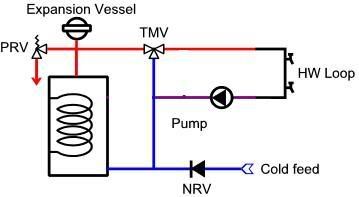- Joined
- 13 Sep 2007
- Messages
- 13
- Reaction score
- 0
- Country

Sorry if this is a bit long, but...
I am setting up a system which incorporates a recirculating DHW loop so that hot water is immediately available at all taps, but I've come up against a problem that I'm not sure how to solve.
It is perhaps worth pointing out that I am based in Spain, that the whole system is solar-based and that there will be no shortage of hot water in the summer!
The first, most obvious solution was like this:

The TMV makes sure the circulating water doesn't get too hot, but there's the problem. Given that we have a LOT of solar heat in the summer, the tank temperature may well rise well above the TMV set temperature. This is fine when the taps are off, as the TMV will circulate the same water which will cool gradually, but when a tap is turned on, where does the water come from? If the tank temp is too high, the TMV will be pulling water from the cool inlet - but this will have to come from the recirculate inlet of the tank, and may well be above the set temp too!
So I came up with option 2:

This gets round the above problem by allowing cold water into the TMV if the tank water is too hot. But now how does the water recirculate when the taps are closed? The TMV tries to draw water from the cold supply because the tank water is too hot, but can't because there is nowhere for it to go!
I'm sure there must be a simple solution, but I'm at a loss as to what it is!
Phil
I am setting up a system which incorporates a recirculating DHW loop so that hot water is immediately available at all taps, but I've come up against a problem that I'm not sure how to solve.
It is perhaps worth pointing out that I am based in Spain, that the whole system is solar-based and that there will be no shortage of hot water in the summer!
The first, most obvious solution was like this:

The TMV makes sure the circulating water doesn't get too hot, but there's the problem. Given that we have a LOT of solar heat in the summer, the tank temperature may well rise well above the TMV set temperature. This is fine when the taps are off, as the TMV will circulate the same water which will cool gradually, but when a tap is turned on, where does the water come from? If the tank temp is too high, the TMV will be pulling water from the cool inlet - but this will have to come from the recirculate inlet of the tank, and may well be above the set temp too!
So I came up with option 2:

This gets round the above problem by allowing cold water into the TMV if the tank water is too hot. But now how does the water recirculate when the taps are closed? The TMV tries to draw water from the cold supply because the tank water is too hot, but can't because there is nowhere for it to go!
I'm sure there must be a simple solution, but I'm at a loss as to what it is!
Phil



